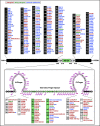Human GATA2 mutations and hematologic disease: how many paths to pathogenesis?
- PMID: 32960960
- PMCID: PMC7509867
- DOI: 10.1182/bloodadvances.2020002953
Human GATA2 mutations and hematologic disease: how many paths to pathogenesis?
Abstract
The surge of human genetic information, enabled by increasingly facile and economically feasible genomic technologies, has accelerated discoveries on the relationship of germline genetic variation to hematologic diseases. For example, germline variation in GATA2, encoding a vital transcriptional regulator of multilineage hematopoiesis, creates a predisposition to bone marrow failure and acute myeloid leukemia termed GATA2 deficiency syndrome. More than 300 GATA2 variants representing missense, truncating, and noncoding enhancer mutations have been documented. Although these variants can diminish GATA2 expression and/or function, the functional ramifications of many variants are unknown. Studies using genetic rescue and knockin mouse systems have established that GATA2 mutations differentially affect molecular processes in distinct target genes and within a single target cell. Considering that target genes for a transcription factor can differ in sensitivity to altered levels of the factor, and transcriptional mechanisms are often cell type specific, the context-dependent consequences of GATA2 mutations in experimental systems portend the complex phenotypes and interindividual variation of GATA2 deficiency syndrome. This review documents GATA2 human genetics and the state of efforts to traverse from physiological insights to pathogenic mechanisms.
© 2020 by The American Society of Hematology.
Conflict of interest statement
Conflict-of-interest disclosure: The authors declare no competing financial interests.
Figures


Similar articles
-
Single-nucleotide human disease mutation inactivates a blood-regenerative GATA2 enhancer.J Clin Invest. 2019 Mar 1;129(3):1180-1192. doi: 10.1172/JCI122694. Epub 2019 Feb 11. J Clin Invest. 2019. PMID: 30620726 Free PMC article.
-
Human leukemia mutations corrupt but do not abrogate GATA-2 function.Proc Natl Acad Sci U S A. 2018 Oct 23;115(43):E10109-E10118. doi: 10.1073/pnas.1813015115. Epub 2018 Oct 9. Proc Natl Acad Sci U S A. 2018. PMID: 30301799 Free PMC article.
-
Sequencing of RNA in single cells reveals a distinct transcriptome signature of hematopoiesis in GATA2 deficiency.Blood Adv. 2020 Jun 23;4(12):2656-2670. doi: 10.1182/bloodadvances.2019001352. Blood Adv. 2020. PMID: 32556286 Free PMC article.
-
Blood disease-causing and -suppressing transcriptional enhancers: general principles and GATA2 mechanisms.Blood Adv. 2019 Jul 9;3(13):2045-2056. doi: 10.1182/bloodadvances.2019000378. Blood Adv. 2019. PMID: 31289032 Free PMC article. Review.
-
GATA2 deficiency.Curr Opin Allergy Clin Immunol. 2015 Feb;15(1):104-9. doi: 10.1097/ACI.0000000000000126. Curr Opin Allergy Clin Immunol. 2015. PMID: 25397911 Free PMC article. Review.
Cited by
-
HMGA1 chromatin regulators induce transcriptional networks involved in GATA2 and proliferation during MPN progression.Blood. 2022 May 5;139(18):2797-2815. doi: 10.1182/blood.2021013925. Blood. 2022. PMID: 35286385 Free PMC article.
-
Loss of GATA2 promotes invasion and predicts cancer recurrence and survival in uterine serous carcinoma.JCI Insight. 2025 Apr 1;10(9):e187073. doi: 10.1172/jci.insight.187073. eCollection 2025 May 8. JCI Insight. 2025. PMID: 40168074 Free PMC article.
-
MonoMAC syndrome with GATA2 novel mutation: A case report.Leuk Res Rep. 2022 Aug 29;18:100346. doi: 10.1016/j.lrr.2022.100346. eCollection 2022. Leuk Res Rep. 2022. PMID: 36119727 Free PMC article.
-
scCASE: accurate and interpretable enhancement for single-cell chromatin accessibility sequencing data.Nat Commun. 2024 Feb 22;15(1):1629. doi: 10.1038/s41467-024-46045-w. Nat Commun. 2024. PMID: 38388573 Free PMC article.
-
hGATA1 Under the Control of a μLCR/β-Globin Promoter Rescues the Erythroid but Not the Megakaryocytic Phenotype Induced by the Gata1 low Mutation in Mice.Front Genet. 2021 Oct 11;12:720552. doi: 10.3389/fgene.2021.720552. eCollection 2021. Front Genet. 2021. PMID: 34707640 Free PMC article.
References
-
- Evans T, Felsenfeld G. The erythroid-specific transcription factor Eryf1: a new finger protein. Cell. 1989;58(5):877-885. - PubMed
-
- Tsai SF, Martin DI, Zon LI, D’Andrea AD, Wong GG, Orkin SH. Cloning of cDNA for the major DNA-binding protein of the erythroid lineage through expression in mammalian cells. Nature. 1989;339(6224):446-451. - PubMed
-
- Wechsler J, Greene M, McDevitt MA, et al. . Acquired mutations in GATA1 in the megakaryoblastic leukemia of Down syndrome. Nat Genet. 2002;32(1):148-152. - PubMed
Publication types
MeSH terms
Substances
Grants and funding
LinkOut - more resources
Full Text Sources
Medical

